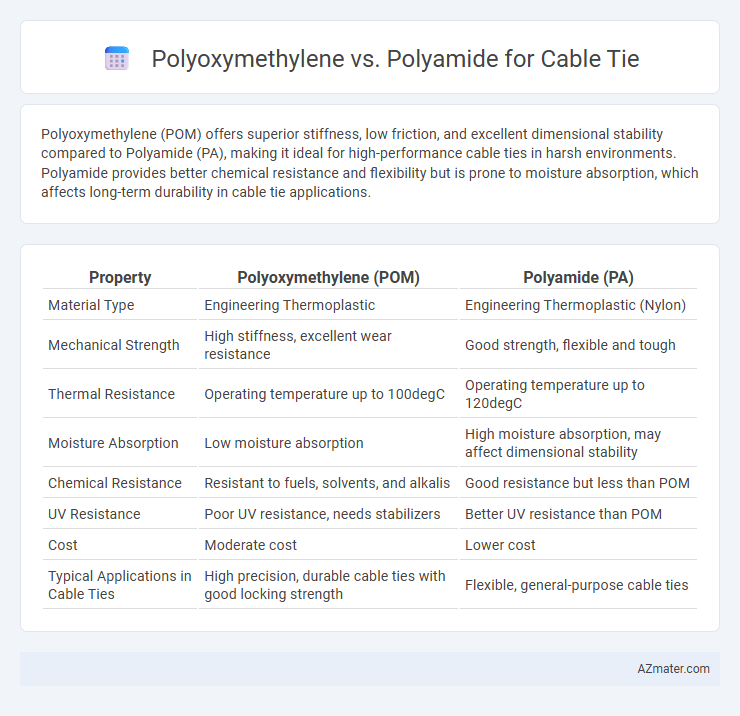Polyoxymethylene (POM) offers superior stiffness, low friction, and excellent dimensional stability compared to Polyamide (PA), making it ideal for high-performance cable ties in harsh environments. Polyamide provides better chemical resistance and flexibility but is prone to moisture absorption, which affects long-term durability in cable tie applications.
Table of Comparison
| Property | Polyoxymethylene (POM) | Polyamide (PA) |
|---|---|---|
| Material Type | Engineering Thermoplastic | Engineering Thermoplastic (Nylon) |
| Mechanical Strength | High stiffness, excellent wear resistance | Good strength, flexible and tough |
| Thermal Resistance | Operating temperature up to 100degC | Operating temperature up to 120degC |
| Moisture Absorption | Low moisture absorption | High moisture absorption, may affect dimensional stability |
| Chemical Resistance | Resistant to fuels, solvents, and alkalis | Good resistance but less than POM |
| UV Resistance | Poor UV resistance, needs stabilizers | Better UV resistance than POM |
| Cost | Moderate cost | Lower cost |
| Typical Applications in Cable Ties | High precision, durable cable ties with good locking strength | Flexible, general-purpose cable ties |
Introduction to Polyoxymethylene and Polyamide
Polyoxymethylene (POM) is a high-performance engineering thermoplastic known for its excellent dimensional stability, low friction, and superior mechanical strength, making it ideal for precise and durable cable tie applications. Polyamide (PA), commonly referred to as nylon, offers strong resistance to abrasion, good flexibility, and inherent chemical resistance, which ensures durability in demanding environments for cable ties. Both materials provide unique advantages, with POM excelling in rigidity and wear resistance, while PA delivers enhanced toughness and environmental adaptability.
Chemical Structure and Composition
Polyoxymethylene (POM) features a formaldehyde-based polymer chain with repeating -CH2O- units, providing high crystallinity and excellent dimensional stability in cable ties. Polyamide (PA), commonly known as nylon, consists of amide linkages (-CONH-) in its backbone, contributing to its superior flexibility and resistance to wear in cable management applications. The chemical structure differences translate to POM's higher rigidity and low moisture absorption compared to PA's enhanced toughness and moisture resistance, influencing their respective performance in varying environmental conditions.
Mechanical Properties Comparison
Polyoxymethylene (POM) offers superior stiffness and tensile strength compared to Polyamide (PA), making it ideal for applications requiring high mechanical durability in cable ties. Polyamide provides better impact resistance and flexibility, enabling cable ties to withstand dynamic loads and vibrations more effectively. Both materials exhibit good wear resistance, but POM's low friction coefficient enhances longevity in repetitive motion environments.
Durability and Environmental Resistance
Polyoxymethylene (POM) offers superior durability and excellent mechanical strength, making it highly resistant to wear and fatigue in cable tie applications. Polyamide (PA), commonly known as nylon, provides enhanced environmental resistance, especially against UV radiation, moisture absorption, and chemical exposure, ensuring long-term performance in harsh outdoor conditions. While POM delivers better dimensional stability and rigidity, PA's flexibility and resistance to environmental degradation make it ideal for applications requiring exposure to variable weather and chemicals.
Performance in High and Low Temperatures
Polyoxymethylene (POM) exhibits superior dimensional stability and mechanical strength at low temperatures, maintaining rigidity without becoming brittle, making it ideal for cold environment applications in cable ties. Polyamide (PA), while also resistant to low temperatures, excels in high-temperature performance with its higher melting point and excellent thermal resistance, ensuring cable ties do not deform or weaken under heat exposure. Choosing between POM and PA depends on the specific temperature range requirements, with POM favored for consistent strength in cold and PA preferred for durability in elevated temperatures.
Flexibility and Tensile Strength
Polyoxymethylene (POM) exhibits high tensile strength and rigidity, making it suitable for cable ties requiring strong holding power but less flexibility. Polyamide (PA), especially Nylon 6/6, offers superior flexibility and impact resistance while maintaining good tensile strength, ideal for applications needing bending and vibration resistance. When choosing materials, polyamide cable ties excel in dynamic environments due to their elasticity, whereas polyoxymethylene ties are preferred for static loads demanding high stiffness.
Applications in Cable Tie Manufacturing
Polyoxymethylene (POM) offers excellent dimensional stability, low friction, and high tensile strength, making it ideal for cable ties used in automotive and electrical applications requiring durability and resistance to harsh environments. Polyamide (PA), commonly known as nylon, provides superior flexibility, chemical resistance, and UV stability, which benefits cable ties exposed to outdoor conditions and varying temperatures. Selecting POM or PA depends on the specific application demands, such as mechanical load, environmental exposure, and regulatory compliance in cable tie manufacturing.
Cost Considerations and Market Availability
Polyoxymethylene (POM) cable ties offer lower material costs and superior mechanical strength compared to polyamide, making them a cost-effective choice for high-performance applications. Polyamide (PA) cable ties dominate the market with extensive availability and established supply chains, benefiting from widespread use and versatile performance in various environments. Cost considerations must balance POM's premium pricing for enhanced durability against polyamide's affordability and ubiquitous market presence.
Environmental Impact and Recyclability
Polyoxymethylene (POM) offers superior durability and chemical resistance but poses challenges in recyclability due to its complex polymer structure, which complicates efficient environmental processing. Polyamide (PA), commonly known as nylon, demonstrates better biodegradability and can be recycled more effectively, supporting lower environmental impact in cable tie applications. Choosing polyamide enhances sustainability efforts through improved recyclability and reduced ecological footprint compared to polyoxymethylene-based cable ties.
Choosing the Right Material for Cable Ties
Polyoxymethylene (POM) offers superior dimensional stability and low friction, making it ideal for cable ties requiring high strength and resistance to wear in mechanical applications. Polyamide (PA), commonly known as nylon, provides excellent flexibility, chemical resistance, and UV resistance, suitable for outdoor cable ties exposed to harsh environmental conditions. Selecting the right material depends on the specific application needs, with POM preferred for precision and durability and PA chosen for versatile, weather-resistant cable fastening.

Infographic: Polyoxymethylene vs Polyamide for Cable Tie
 azmater.com
azmater.com